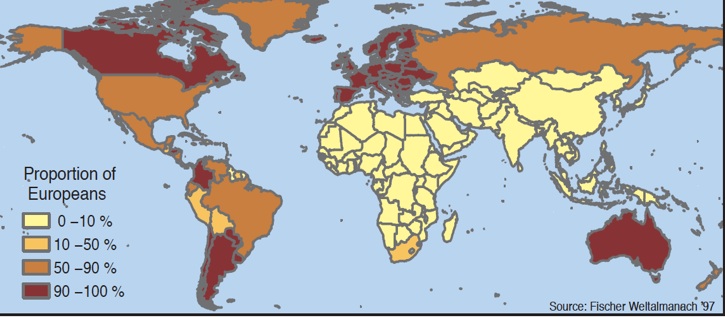Navigation auf uzh.ch
Navigation auf uzh.ch
1. What is this section about?
This section offers arguments and material that may explain differences in development of the non-European world. More specifically, it is suggested that modern development (since 1960) is highly influenced by the sociopolitical organization of precolonial societies. This approach is strongly supported by Research Results that were elaborated with the data of the „Atlas of Precolonial Societies“.
2. What is meant by Pre-colonial Societal Structures?
This website considers three elements of precolonial social structures:
Together, this is what constitutes the cultural heritage of developing countries.
3. Which developing countries?
The analysis includes countries where people of European background are absent or represent a small minority. Countries where people of European background are more prominent (e.g. in Israel), as well as dependent territories, city states or tiny countries are excluded since they would not allow us to test the effects of the local cultural heritage on development.

The „non-European“ world (yellow): A contiguous block of 95 countries where people of European origin count for less than 10 % of the population (exception: South Africa with an 18% white population). The few South American countries where Europeans form a strong minority are not part of this research.
List of Countries (PDF, 11 KB)
4. How to measure the cultural heritage and how to analyze it?
The cultural heritage is measured on the level of local groups: We take data from various individual tribes, communities, or “cultural units,” and aggregate it to a national level for each country. Based on 2‘440 such cultural units, about 90 % of the African/Asian population (in 1960) are coded and documented in 12 regional maps (identification maps).
Each cultural unit is described by a number of variables on the economic, political and social traits of the traditional organization as described by anthropologists during colonial times (mainly between 1890 and 1950). The spacial distribution of these cultural traits (or their configurations) is shown in three different types of thematic maps.
On the way to exploring questions about development in different parts of the world, we found it helpful to visualize the data. The resulting maps were rich and useful: a fortunate side product of our original investigation. They are offered on two analytical levels: On the ethnic level, the matrix contains 2440 cultural units and 43 variables. On the national level, the matrix contains 87 African and Asian countries and 54 Indian/Chinese States/Provinces; they are documented by 33 ranked variables/indices and 39 cultural types. The data can be downloaded as Excel files under Data Bank.
5. How to browse through the website?
On top of each page there are seven main menus. The content of the cultural heritage is defined under Cultural Heritage; the definition of which social groups have been coded as well as methodological remarks are provided under Cultural Units.
Each main menu overarches submenus which are found in a box on the top left. Visiting Summary Table Content and Type of maps provides a quick overview. For theoretical considerations, go to Approach.
6. Who is behind this Website?
Ten years after the publication of the Atlas of Pre-Colonial Societies (in German), the main parts of the book are now presented on the internet, together with more maps and new analyses ( Research). The ATLAS was developed at the Institute of Social Anthropology, University of Zurich (Switzerland) and first published in 1999.